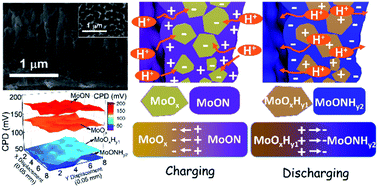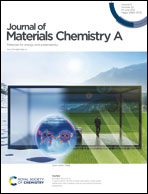Tunable built-in electric fields enable high-performance one-dimensional co-axial MoOx/MoON heterojunction nanotube arrays for thin-film pseudocapacitive charge storage devices†
Abstract
Battery-type electrode materials show inferior power density due to sluggish ion-diffusion kinetics within the solid phase. Herein, we outline a strategy to improve the cation migration for ultrafast energy storage by utilizing a built-in electric field (BEF) at the heterostructure interface. Both theoretical calculations and Kelvin probe measurements reveal that two kinds of BEF – in opposite directions – are produced at fully charged and discharged states on co-axial MoOx/MoON nanotubes (NTs). The transport kinetics are greatly increased by the BEF effect, leading to a dramatic increase of capacitance, especially at a high charging rate. Subsequently, MoOx/MoON NTs exhibit a specific capacitance of 1976 F cm−3 at a current density of 2.5 A cm−3. And 1267 F cm−3 is retained at a high current density of 100 A cm−3, which can be ascribed to the improvement of fast ionic transport in the electrode bulk caused by the BEF effect. This work also inspires a new pathway toward rational engineering of heterostructures for high-capacitance and high-rate energy storage.



 Please wait while we load your content...
Please wait while we load your content...